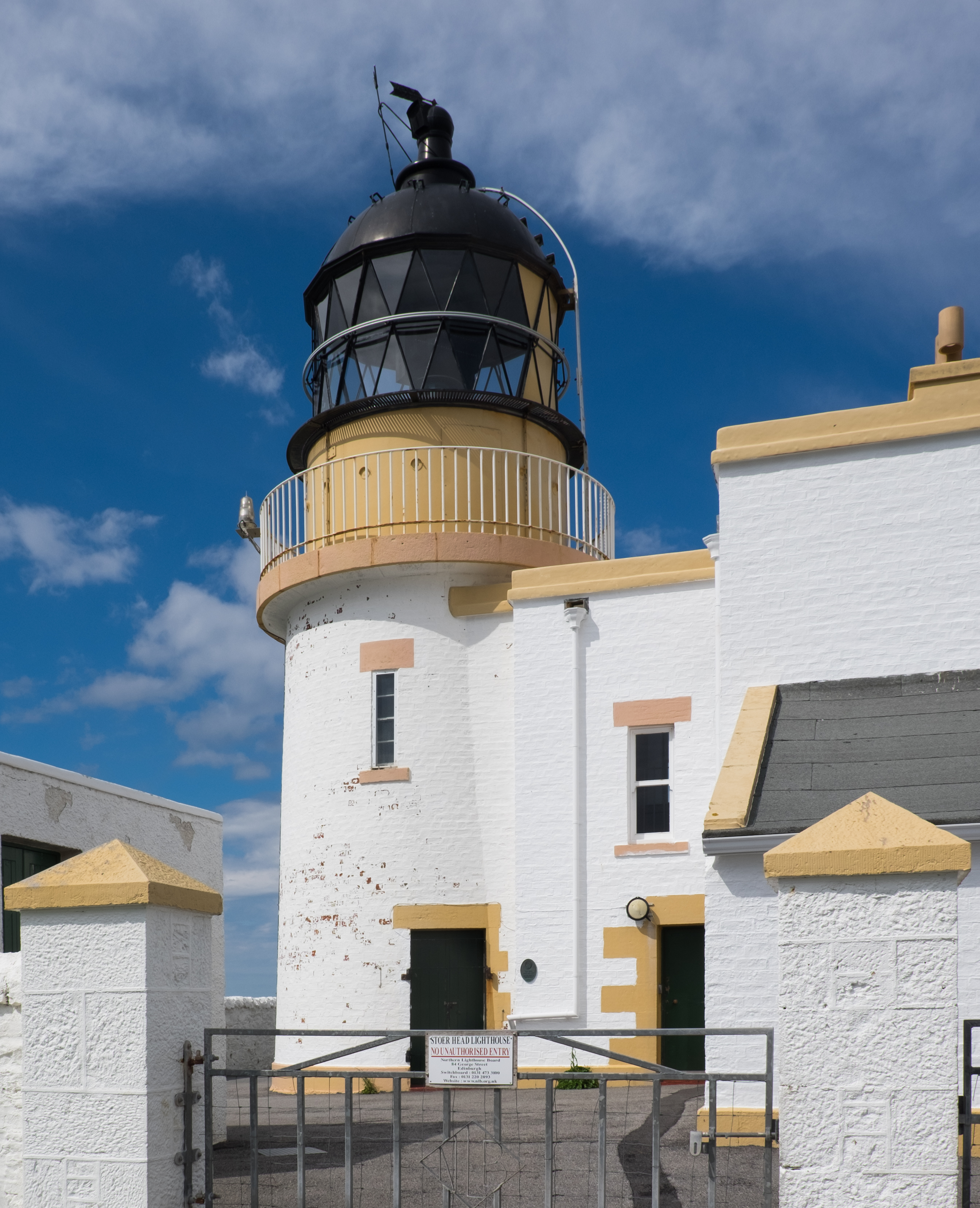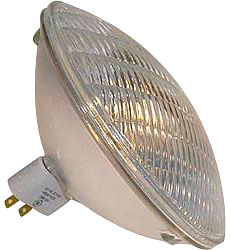|
Stoer Head Lighthouse
Stoer Head Lighthouse was built on Stoer Head by brothers David and Thomas Stevenson in 1870 after being identified as one of forty-five sites in Scotland where a lighthouse was necessary to protect shipping. The lighthouse is high, making it squat in appearance, but the height of the cliffs on which it sits means it can be seen at a distance of out at sea. The beacon flashes white every fifteen seconds. Location The lighthouse is at grid reference NC003330 at the end of a 5 km long track which branches off the B869 Lochinver to Unapool road. Further North up the coast are the Old Man of Stoer and the Point of Stoer, which can easily be reached from the lighthouse on foot. Around 10,000 visitors visit the lighthouse each year, necessitating the construction of a public toilet in 2013. The two keepers cottages have are now holiday homes. Construction Sea transport in the 1870s being the only feasible option for this remote site, the stone and other materials for the lig ... [...More Info...] [...Related Items...] OR: [Wikipedia] [Google] [Baidu] |
David Stevenson (engineer)
David Stevenson MICE FRSE FRSSA (11 January 1815 – 17 July 1886) was a Scottish lighthouse designer, who designed over 30 lighthouses in and around Scotland, and helped continue the dynasty of lighthouse engineering founded by his father. Life He was born on 11 January 1815 at 2 Baxters Place at the top of Leith Walk in Edinburgh, the son of Jean Smith and engineer Robert Stevenson. He was brother of the lighthouse engineers Alan and Thomas Stevenson. He was educated at the High School in Edinburgh then studied at the University of Edinburgh. In 1838 he became a partner in his father's (and uncle's) firm of R & A Stevenson. In 1844 he was elected a Fellow of the Royal Society of Edinburgh his proposer being David Milne-Home. In 1853 he moved to the Northern Lighthouse Board. Between 1854 and 1880 he designed many lighthouses, all with his brother Thomas. In addition he helped Richard Henry Brunton design lighthouses for Japan, inventing a novel method for allowing them to ... [...More Info...] [...Related Items...] OR: [Wikipedia] [Google] [Baidu] |
Thomas Stevenson
Thomas Stevenson PRSE MInstCE FRSSA FSAScot (22 July 1818 – 8 May 1887) was a pioneering Scottish civil engineer, lighthouse designer and meteorologist, who designed over thirty lighthouses in and around Scotland, as well as the Stevenson screen used in meteorology. His designs, celebrated as ground breaking, ushered in a new era of lighthouse creation. He served as president of the Royal Scottish Society of Arts (1859–60), as president of the Royal Society of Edinburgh (1884–86), and was a co-founder of the Scottish Meteorological Society. Life He was born at 2 Baxters Place in Edinburgh, on 22 July 1818, the youngest son of engineer Robert Stevenson, and his wife (and step-sister) Jean Smith. He was educated at the Royal High School in Edinburgh. Thomas Stevenson was a devout and regular attendee at St. Stephen's Church in Stockbridge, at the north end of St Vincent Street, Edinburgh. He lived with his family at Baxters Place until he got married in 1848. He then go ... [...More Info...] [...Related Items...] OR: [Wikipedia] [Google] [Baidu] |
Point Of Stoer
Point or points may refer to: Places * Point, Lewis, a peninsula in the Outer Hebrides, Scotland * Point, Texas, a city in Rains County, Texas, United States * Point, the NE tip and a ferry terminal of Lismore, Inner Hebrides, Scotland * Points, West Virginia, an unincorporated community in the United States Business and finance * Point (loyalty program), a type of virtual currency in common use among mercantile loyalty programs, globally *Point (mortgage), a percentage sometimes referred to as a form of pre-paid interest used to reduce interest rates in a mortgage loan * Basis point, 1/100 of one percent, denoted ''bp'', ''bps'', and ''‱'' * Percentage points, used to measure a change in percentage absolutely * Pivot point (technical analysis), a price level of significance in analysis of a financial market that is used as a predictive indicator of market movement * "Points", the term for profit sharing in the American film industry, where creatives involved in making the ... [...More Info...] [...Related Items...] OR: [Wikipedia] [Google] [Baidu] |
Jetty
A jetty is a structure that projects from land out into water. A jetty may serve as a breakwater, as a walkway, or both; or, in pairs, as a means of constricting a channel. The term derives from the French word ', "thrown", signifying something thrown out. For regulating rivers Another form of jetties, wing dams are extended out, opposite one another, ''from each bank of a river'', at intervals, to contract a wide channel, and by concentration of the current to produce a deepening. At the outlet of tideless rivers Jetties have been constructed on each side of the outlet river of some of the rivers flowing into the Baltic, with the objective of prolonging the scour of the river and protecting the channel from being shoaled by the littoral drift along the shore. Another application of parallel jetties is in lowering the bar in front of one of the mouths of a deltaic river flowing into a tide — a virtual prolongation of its less sea, by extending the scour of the rive ... [...More Info...] [...Related Items...] OR: [Wikipedia] [Google] [Baidu] |
Bothy
A bothy is a basic shelter, usually left unlocked and available for anyone to use free of charge. It was also a term for basic accommodation, usually for gardeners or other workers on an estate. Bothies are found in remote mountainous areas of Scotland, Northern England, Ulster and Wales. They are particularly common in the Scottish Highlands, but related buildings can be found around the world (for example, in the Nordic countries there are wilderness huts). A bothy was also a semi-legal drinking den in the Isle of Lewis. These, such as ''Bothan Eòrapaidh'', were used until recent years as gathering points for local men and were often situated in an old hut or caravan. In Scots law, bothies are defined in law as: a building of no more than two storeys which— (a)does not have any form of— (i)mains electricity, (ii)piped fuel supply, and (iii)piped mains water supply, (b)is 100 metres or more from the nearest public road (within the meaning of section 151 of the Roads (S ... [...More Info...] [...Related Items...] OR: [Wikipedia] [Google] [Baidu] |
Stoer Head Lighthouse Light Tower
Stoer ( gd, An Stòr) is a crofting township in the parish of Assynt, Sutherland, in the Highlands of Scotland and in the council area of Highland Highlands or uplands are areas of high elevation such as a mountainous region, elevated mountainous plateau or high hills. Generally speaking, upland (or uplands) refers to ranges of hills, typically from up to while highland (or highlands) is .... It is located about five miles north of the village of Lochinver. Norman McLeod, a presbyterian minister who led a group of emigrants to Nova Scotia and New Zealand, came from Stoer. The Old Man of Stoer, a sea stack, and the lighthouse on Stoer Head are directly accessible from Stoer, being less than 4 miles north/north west of the village. Rev Farquhar Matheson, minister of the parish from 1920, served as Moderator of the General Assembly of the Free Church of Scotland in 1939. References {{reflist Populated places in Sutherland ... [...More Info...] [...Related Items...] OR: [Wikipedia] [Google] [Baidu] |
Stoer
Stoer ( gd, An Stòr) is a crofting township in the parish of Assynt, Sutherland, in the Highlands of Scotland and in the council area of Highland. It is located about five miles north of the village of Lochinver. Norman McLeod, a presbyterian minister who led a group of emigrants to Nova Scotia and New Zealand, came from Stoer. The Old Man of Stoer, a sea stack, and the lighthouse on Stoer Head are directly accessible from Stoer, being less than 4 miles north/north west of the village. Rev Farquhar Matheson, minister of the parish from 1920, served as Moderator of the General Assembly The moderator of the General Assembly is the chairperson of a General Assembly, the highest court of a Presbyterian or Reformed church. Kirk sessions and presbyteries may also style the chairperson as moderator. The Oxford Dictionary states t ... of the Free Church of Scotland in 1939. References {{reflist Populated places in Sutherland ... [...More Info...] [...Related Items...] OR: [Wikipedia] [Google] [Baidu] |
Sutherland
Sutherland ( gd, Cataibh) is a historic county, registration county and lieutenancy area in the Highlands of Scotland. Its county town is Dornoch. Sutherland borders Caithness and Moray Firth to the east, Ross-shire and Cromartyshire (later combined into Ross and Cromarty) to the south and the Atlantic to the north and west. Like its southern neighbour Ross-shire, Sutherland has some of the most dramatic scenery in Europe, especially on its western fringe where the mountains meet the sea. These include high sea cliffs, and very old mountains composed of Precambrian and Cambrian rocks. The name ''Sutherland'' dates from the era of Norwegian Viking rule and settlement over much of the Highlands and Islands, under the rule of the jarl of Orkney. Although it contains some of the northernmost land in the island of Great Britain, it was called ' ("southern land") from the standpoint of Orkney and Caithness. In Gaelic, the area is referred to according to its traditional areas: ' ... [...More Info...] [...Related Items...] OR: [Wikipedia] [Google] [Baidu] |
Sealed Beam
A parabolic aluminized reflector lamp (PAR lamp or simply PAR) is a type of electric lamp that is widely used in commercial, residential, and transportation illumination. It produces a highly directional beam. Usage includes theatrical lighting, locomotive headlamps, aircraft landing lights, and residential and commercial recessed lights ("cans" in the United States). Many PAR lamps are of the sealed beam variety, with a parabolic reflector, one or more filaments, and a glass or plastic lens sealed permanently together as a unit. Originally introduced for road vehicle headlamp service, sealed beams have since been applied elsewhere. Halogen sealed beam lamps incorporate a halogen lamp within a quartz or hard glass envelope. Construction A PAR lamp consists of a light source, with lens and a parabolic reflector with a smooth aluminium surface determining the spread of the beam. The most common sealed beam type combines these three elements into an integral unit. The light ... [...More Info...] [...Related Items...] OR: [Wikipedia] [Google] [Baidu] |
Northern Lighthouse Board
The Northern Lighthouse Board (NLB) is the general lighthouse authority for Scotland and the Isle of Man. It is a non-departmental public body responsible for marine navigation aids around coastal areas. History The NLB was formed by Act of Parliament in 1786 as the Commissioners of Northern Light Houses, largely at the urging of the lawyer and politician George Dempster ("Honest George"), to oversee the construction and operation of four Scottish lighthouses: Kinnaird Head, North Ronaldsay, Scalpay and Mull of Kintyre, for which they were empowered to borrow up to £1,200. Until then, the only major lighthouse in Scotland was the coal brazier mounted on the Isle of May in the Firth of Forth, together with some smaller lights in the Firths of the Tay and Clyde. None of the major passages around Scotland, which led through dangerous narrows, were marked. The commissioners, whose first president was the Lord Provost of Edinburgh, Sir James Hunter-Blair, advertised for buildin ... [...More Info...] [...Related Items...] OR: [Wikipedia] [Google] [Baidu] |


.jpg)


